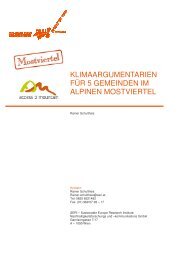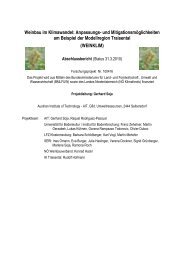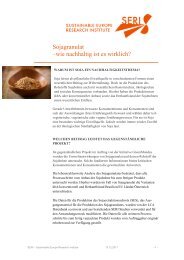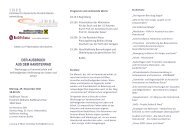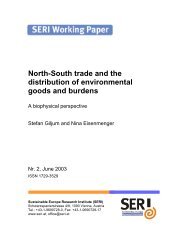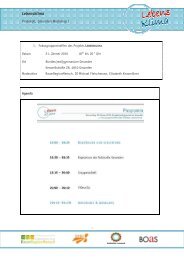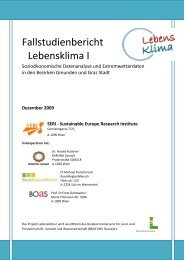Organic food in Austria: Production and Consumption Patterns
Organic food in Austria: Production and Consumption Patterns
Organic food in Austria: Production and Consumption Patterns
You also want an ePaper? Increase the reach of your titles
YUMPU automatically turns print PDFs into web optimized ePapers that Google loves.
Over the years, organic farmers have become more <strong>and</strong> more<br />
organized, with over 70% be<strong>in</strong>g members of umbrella organizations. Of these,<br />
87% are part of the largest <strong>Austria</strong>n organization for organic farmers, Bio<br />
Ernte <strong>Austria</strong>, which have their own criteria, sometimes stricter than EU<br />
st<strong>and</strong>ards.<br />
Comparable to other European countries, dur<strong>in</strong>g the past 20 years,<br />
many different organic associations developed, either on a regional level or<br />
with a different underst<strong>and</strong><strong>in</strong>g of "organic culture". This has lead to a difficult<br />
situation of differ<strong>in</strong>g <strong>and</strong> compet<strong>in</strong>g <strong>in</strong>terests, which even weakened the<br />
importance of organic agriculture's associations <strong>in</strong> <strong>Austria</strong>. After the “Bio-<br />
Enquete 2002” the situation changed: The M<strong>in</strong>ister of Agriculture at that time,<br />
Wilhelm Molterer, <strong>in</strong>structed the chairman of ARGE Biol<strong>and</strong>bau to <strong>in</strong>itiate the<br />
formation of a competence centre for organic agriculture. S<strong>in</strong>ce beg<strong>in</strong>n<strong>in</strong>g of<br />
2003, organic umbrella organizations (ARGE Bio-L<strong>and</strong>bau <strong>and</strong> ÖIG, Bio-Ernte<br />
<strong>Austria</strong>'s federal organization) <strong>and</strong> their member associations are work<strong>in</strong>g on<br />
a complete change of the situation <strong>in</strong> <strong>Austria</strong>. “The umbrella organizations will<br />
be united <strong>and</strong> replaced by one new association "BIO AUSTRIA". Advisory,<br />
quality management, product management, research <strong>and</strong> <strong>in</strong>novation,<br />
consumer <strong>in</strong>formation, market<strong>in</strong>g, etc. are organized <strong>in</strong> a better, much more<br />
efficient way, which will give farmers <strong>and</strong> processors better service <strong>and</strong><br />
consumers more security <strong>and</strong> quality” (Kl<strong>in</strong>gbacher, 2004).<br />
Altogether, this streaml<strong>in</strong><strong>in</strong>g aligns very well with the requirements of<br />
the big supermarkets that force organic farmers to rationalize <strong>and</strong> to decrease<br />
their production costs. Nigg <strong>and</strong> Schermer (2005), however, ask whether the<br />
<strong>Austria</strong>n focus on organic farm<strong>in</strong>g is actually a real change <strong>in</strong> the direction of<br />
<strong>Austria</strong>n agriculture, or just the conventional <strong>food</strong> sector us<strong>in</strong>g consumers’<br />
trust <strong>in</strong> organic <strong>food</strong> to their advantage. They also po<strong>in</strong>t out that due to the<br />
<strong>in</strong>creas<strong>in</strong>g dem<strong>and</strong> for processed organic <strong>food</strong>, such as microwave meals,<br />
frozen <strong>food</strong>, etc. the process<strong>in</strong>g of organic <strong>food</strong> is, <strong>in</strong> their op<strong>in</strong>ion, identical to<br />
that of conventional <strong>food</strong>. This, they argue, reduces the concept of organic to<br />
the production of the raw materials. The orig<strong>in</strong>ally closed cycle of production<br />
of organic <strong>food</strong>, i.e. regional production <strong>and</strong> consumption, is now be<strong>in</strong>g<br />
opened, which <strong>in</strong>creases the risks of problems <strong>and</strong> <strong>food</strong> sc<strong>and</strong>als (Nigg <strong>and</strong><br />
Schermer, 2005 p. 106).<br />
Because organic farmers receive a larger percentage of their <strong>in</strong>come<br />
as subsidies than conventional farmers, their average <strong>in</strong>come is higher. On<br />
average, organic farmers are less <strong>in</strong>debted (vital for bus<strong>in</strong>ess-stability) <strong>and</strong><br />
receive a higher <strong>in</strong>come than conventional farmers, due to subsidies. The




